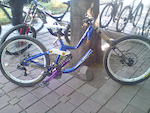You are using an out of date browser. It may not display this or other websites correctly.
You should upgrade or use an alternative browser.
You should upgrade or use an alternative browser.
2013 Kona Range.
- Thread starter Kona-Ian
- Start date
gradeAfailure
Senior Retro Guru
Best tell Kona that and they can change it then - thank goodness you realised something a multi-million dollar company with experienced and professional CAD designers didn't! :roll:coomber":xwt67epz said:The hydro forming on the full sussers is ...pointless...
The double-S bend on the down tube of the Entourage, for example, gives clearance for the fork crowns on single-crown forks, and clearance for the remote reservoir of the rear shock under full compression, amongst other things.
gradeAfailure":t90f1hqo said:Best tell Kona that and they can change it then - thank goodness you realised something a multi-million dollar company with experienced and professional CAD designers didn't! :roll:coomber":t90f1hqo said:The hydro forming on the full sussers is ...pointless...
The double-S bend on the down tube of the Entourage, for example, gives clearance for the fork crowns on single-crown forks, and clearance for the remote reservoir of the rear shock under full compression, amongst other things.
:roll:
And what point does the curved top tube add, as rider clearance clearly isnt an issue on them?
If you are going to be pedantic about it, the bend on the down tube is to maximise the contact area in the top and down tube for strength, nothing to do with fork clearance
coomber":2zn0ysm1 said:gradeAfailure":2zn0ysm1 said:Best tell Kona that and they can change it then - thank goodness you realised something a multi-million dollar company with experienced and professional CAD designers didn't! :roll:coomber":2zn0ysm1 said:The hydro forming on the full sussers is ...pointless...
The double-S bend on the down tube of the Entourage, for example, gives clearance for the fork crowns on single-crown forks, and clearance for the remote reservoir of the rear shock under full compression, amongst other things.
:roll:
And what point does the curved top tube add, as rider clearance clearly isnt an issue on them?
If you are going to be pedantic about it, the bend on the down tube is to maximise the contact area in the top and down tube for strength, nothing to do with fork clearance
and if you want to be really pedantic.... the reason it broke is explained in the original post you linked to... :roll: not specifically the tubing itself, more the impact, bend, then continued riding
finnbjorn96":2zn0ysm1 said:the bike in the picture belonged to a friend of mine. the reason it broke like that is because he hit a tree face first with it and it dented inward.

After two weeks of riding it finally broke.
Crikey, thought I was on bikeradar with the handbags going on there. 
All about personal opinions guys!
For what its worth, I agree that Kona's engineers must see some merit, but it would be naive to think it is purely about function or a perceived advantage - at the end of the say it is largely about what sells, and bendy frames like those are selling. Whether they are necessary or not is another matter.
Would be interesting to see how the impact that wrote that frame off would have manifested itself in a more traditional shaped/tubed frame.
All about personal opinions guys!
For what its worth, I agree that Kona's engineers must see some merit, but it would be naive to think it is purely about function or a perceived advantage - at the end of the say it is largely about what sells, and bendy frames like those are selling. Whether they are necessary or not is another matter.
Would be interesting to see how the impact that wrote that frame off would have manifested itself in a more traditional shaped/tubed frame.
According to Wiki":22qnde0b said:Hydroforming is a cost-effective way of shaping ductile metals such as aluminum, brass, low alloy steels, stainless steel into lightweight, structurally stiff and strong pieces. One of the largest applications of hydroforming is the automotive industry, which makes use of the complex shapes possible by hydroforming to produce stronger, lighter, and more rigid unibody structures for vehicles. This technique is particularly popular with the high-end sports car industry and is also frequently employed in the shaping of aluminium tubes for bicycle frames. Hydroforming is a specialized type of die forming that uses a high pressure hydraulic fluid to press room temperature working material into a die. To hydroform aluminum into a vehicle's frame rail, a hollow tube of aluminum is placed inside a negative mold that has the shape of the desired result. High pressure hydraulic pumps then inject fluid at very high pressure inside the aluminum which causes it to expand until it matches the mold. The hydroformed aluminum is then removed from the mold. Hydroforming allows complex shapes with concavities to be formed, which would be difficult or impossible with standard solid die stamping. Hydroformed parts can often be made with a higher stiffness-to-weight ratio and at a lower per unit cost than traditional stamped or stamped and welded parts. Virtually all metals capable of cold forming can be hydroformed, including aluminum, brass, carbon and stainless steel, copper, and high strength alloys
Reading this, the advantages, and therefore reasons why it would be used is clear.... Cheap, strong, light, complex shapes, high stiff/weight ratio (steady....
G
Similar threads
- Replies
- 69
- Views
- 3K
- Replies
- 5
- Views
- 280